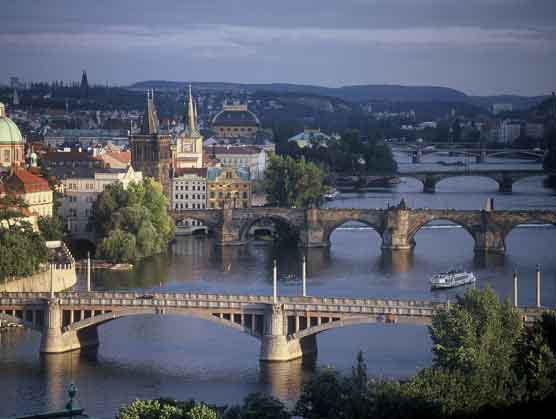There's something magical about Prague. Perhaps it's the gothic architecture. Perhaps it's the art nouveau streets. Maybe it's because Prague has some of the most beautiful historic architecture true to form. Perhaps it's because Europe's most popular tourist destination was virtually unvisited by tourists until the Fall of Communism in 1989.

Wenceslas Square
Wenceslas Square is a vibrant area of restaurants and shops
Laid out over 600 years ago by King Charles IV, it was originally used as the Prague horse market.
Today, the only horse you will see is the one on top of the street carrying the legendary King Wencelas.
Today, the only horse you will see is the one on top of the street carrying the legendary King Wencelas.
Over the years, the square has been a regular parade ground for all kinds of events and celebrations
At the top is the statue of St. Wenceslas on his horse cutting a striking figure
This is good King Wenceslas, a national hero, murdered over a thousand years ago by his brother.
In front of St. Wenceslas are two plaques in memory of those killed during the Communist era.
Prague was the seat of two holy Roman Emperors and thus was also the capital of the Holy Roman Empire City flourished during the 14th century reign of the King of Bohemia.
In 1945, the people of Prague revolted against the Nazis. The Nazis retaliated covering the Square and the city with smoke and fire. It was a dark time, but the people of Prague revolted and were succeeded in squashing the enemy.
Shortly after the war, the Communist Party began its rule. They ruled until 1989 when the people of Czechoslovakia protested during the Velvet Revolution. On November 17, 1989, riot police suppressed a peaceful student demonstration in Prague. That event sparked more demonstrations to late December. The number of protestors grew from a couple hundred thousand to half a million.
These protests were successful in pressuring the Communist Party of Czechoslovakia to dismantle communism. The next year, the country held its first democratic elections since 1946.
In 1945, the people of Prague revolted against the Nazis. The Nazis retaliated covering the Square and the city with smoke and fire. It was a dark time, but the people of Prague revolted and were succeeded in squashing the enemy.
Shortly after the war, the Communist Party began its rule. They ruled until 1989 when the people of Czechoslovakia protested during the Velvet Revolution. On November 17, 1989, riot police suppressed a peaceful student demonstration in Prague. That event sparked more demonstrations to late December. The number of protestors grew from a couple hundred thousand to half a million.
These protests were successful in pressuring the Communist Party of Czechoslovakia to dismantle communism. The next year, the country held its first democratic elections since 1946.

Charles Bridge
Beautiful Charles Bridge is the postcard of this great city. Today it looks just the same as it did in the 14th century. In the center of the bridge is the St John of Nepomuk statue.You're supposed to touch it with your left hand, then make a wish, you almost have to.
Prague Castle
The Prague Castle stands atop the hills
The stones grow even stronger
For the castle's built on love and hope
Alone you are no longer
Old Town Square
Step into the Old Town Square and journey back in time, 700 years
As you stand in awe, the dramatic history of Prague permeates the air
Sit back and soak up the atmosphere
Dating back to the late 12th century, the Old Town Square
Jindrisska Tower
Jindrisska Tower dates from the late gothic era
Following a major fire in 1745, Jindrisska was rebuilt in the baroque style
At the top, visitors can enjoy a panoramic view of Prague's city center
Jindrisska is so peaceful, you might be up there for a while




No comments:
Post a Comment